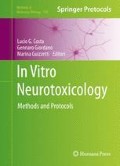Abstract
Glutamate is the mayor excitatory neurotransmitter in vertebrate nervous system. It has a crucial role in most brain functions under physiological conditions through the activation of both ionotropic and metabotropic glutamate receptors. In addition, extracellular glutamate concentration is tightly regulated through different excitatory amino acid transporters (EAAT). Glutamate neurotransmission is also involved in the neurotoxic effects of many environmental chemicals and drugs. Furthermore, homeostatic changes in glutamate neurotransmission appear in response to prolonged block/enhancement of electrical activity. Here, we describe different approaches to evaluate alterations in glutamate neurotransmission regarding glutamate receptors and glutamate transporters by using primary cultures of neurons and astrocytes. The methods are based on the increased fluorescence of calcium-sensitive probes in response to glutamate agonists, on radioligand binding to glutamate receptors and transport sites, and on inmunocytochemistry visualization of glutamate receptors.
Access this chapter
Tax calculation will be finalised at checkout
Purchases are for personal use only
References
Olney J.W. (1969) Brain lesions, obesity, and other disturbances in mice treated with monosodium glutamate. Science 164, 719–721.
Choi D.W. (1988) Glutamate neurotoxicity and diseases of the nervous system. Neuron 1, 623–634.
Tordera R.M., Totterdell S., Wojcik S.M. et al. (2007) Enhanced anxiety, depressive-like behaviour and impaired recognition memory in mice with reduced expression of the vesicular glutamate transporter 1 (VGLUT1). Eur J Neurosci 25, 281–290.
Olney J.W. and Farber N.B. (1995) Glutamate receptor dysfunction and schizophrenia. Arch Gen Psychiatry 52, 998–1007.
Allen J.W., Mutkus L.A. and Aschner M. (2001) Methylmercury-mediated inhibition of 3H-D-aspartate transport in cultured astrocytes is reversed by the antioxidant catalase. Brain Res 902, 92–100.
Fonfría E., Vilaró M.T., Babot Z. et al. (2005) Mercury compounds disrupt neuronal glutamate transport in cultured mouse cerebellar granule cells. J Neurosci Res 79, 545–553.
Vale C., Damgaard I., Suñol C. et al. (1998) Cytotoxic action of lindane in cerebellar granule neurons is mediated by interaction with inducible GABA(B) receptors. J Neurosci Res 52, 286–294.
Briz V., Galofré M. and Suñol C. (2010) Reduction of glutamatergic neurotransmission by prolonged exposure to dieldrin involves NMDA receptor internalization and metabotropic glutamate receptor 5 downregulation. Toxicol Sci 113, 138–149.
Babot Z., Vilaró M.T. and Suñol C. (2007) Long-term exposure to dieldrin reduces gamma-aminobutyric acid type A and N-methyl-D-aspartate receptor function in primary cultures of mouse cerebellar granule cells. J Neurosci Res 85, 3687–3695.
Anis N.A., Berry S.C., Burton N.R. and Lodge D. (1983) The dissociative anaesthetics, ketamine and phencyclidine, selectively reduce excitation of central mammalian neurones by N-methyl-aspartate. Br J Pharmacol 79, 565–575.
Crump F.T., Dillman K.S. and Craig A.M. (2001) cAMP-dependent protein kinase mediates activity-regulated synaptic targeting of NMDA receptors. J Neurosci 21, 5079–5088.
Watt A.J., van Rossum M.C., MacLeod K.M. et al. (2000) Activity coregulates quantal AMPA and NMDA currents at neocortical synapses. Neuron 26, 659–670.
Bouchelouche P., Belhage B., Frandsen A. et al. (1989) Glutamate receptor activation in cultured cerebellar granule cells increases cytosolic free Ca2+ by mobilization of cellular Ca2+ and activation of Ca2+ influx. Exp Brain Res 76, 281–291.
Gegelashvili G., Danbolt N.C. and Schousboe A. (1997) Neuronal soluble factors differentially regulate the expression of the GLT1 and GLAST glutamate transporters in cultured astroglia. J Neurochem 69, 2612–2615.
Nakanishi S. (1994) Metabotropic glutamate receptors: synaptic transmission, modulation, and plasticity. Neuron 13, 1031–1037.
Reynolds I.J. (2001) Measurement of cation movement in primary cultures using fluorescent dyes. Curr Protoc Neurosci Chapter 7, Unit 7.
Schwarz S., Zhou G.Z., Katki A.G. and Rodbard D. (1990) L-homocysteate stimulates [3H]MK-801 binding to the phencyclidine recognition site and is thus an agonist for the N-methyl-D-aspartate-operated cation channel. Neuroscience 37, 193–200.
Murray F., Kennedy J., Hutson P.H. et al (2000) Modulation of [3H]MK-801 binding to NMDA receptors in vivo and in vitro. Eur J Pharmacol 397, 263–270.
Itzhak Y. and Stein I. (1992) Sensitization to the toxic effects of cocaine in mice is associated with the regulation of N-methyl-D-aspartate receptors in the cortex. J Pharmacol Exp Ther 262, 464–470.
De Blasi A., O’Reilly K. and Motulsky H.J. (1989) Calculating receptor number from binding experiments using same compound as radioligand and competitor. Trends Pharmacol Sci 10, 227–229.
Erikson K. and Aschner M. (2002) Manganese causes differential regulation of glutamate transporter (GLAST) taurine transporter and metallothionein in cultured rat astrocytes. Neurotoxicology 23, 595–602.
Johnson J.W. and Ascher P. (1984) Glycine potentiates the NMDA response in cultured mouse brain neurons. Nature 325, 529–531.
Nowak L., Bregestovski P. and Ascher P. (1984) Magnesium gates glutamate-activated channels in mouse central neurones. Nature 307, 462–465.
Javitt D.C. and Zukin S.R. (1989) Interaction of [3H]MK-801 with multiple states of the N-methyl-D-aspartate receptor complex of rat brain. Proc Natl Acad Sci USA 86, 740–744.
Frandsen A. and Schousboe A. (1990) Development of excitatory amino acid induced cytotoxicity in cultured neurons. Int J Dev Neurosci 8, 209–216.
Pertusa M., García-Matas S., Rodríguez-Farré E. et al (2007) Astrocytes aged in vitro show a decreased neuroprotective capacity. J Neurochem 101, 794–805.
Acknowledgments
This work was supported by grant PI 06/1212 (Spanish Ministry of Health) and SGR 2009/SGR/214 (Generalitat de Catalunya, Spain).
Author information
Authors and Affiliations
Corresponding author
Editor information
Editors and Affiliations
Rights and permissions
Copyright information
© 2011 Springer Science+Business Media, LLC
About this protocol
Cite this protocol
Briz, V., Suñol, C. (2011). Homeostatic Regulation of Glutamate Neurotransmission in Primary Neuronal Cultures. In: Costa, L., Giordano, G., Guizzetti, M. (eds) In Vitro Neurotoxicology. Methods in Molecular Biology, vol 758. Humana Press, Totowa, NJ. https://doi.org/10.1007/978-1-61779-170-3_17
Download citation
DOI: https://doi.org/10.1007/978-1-61779-170-3_17
Published:
Publisher Name: Humana Press, Totowa, NJ
Print ISBN: 978-1-61779-169-7
Online ISBN: 978-1-61779-170-3
eBook Packages: Springer Protocols

